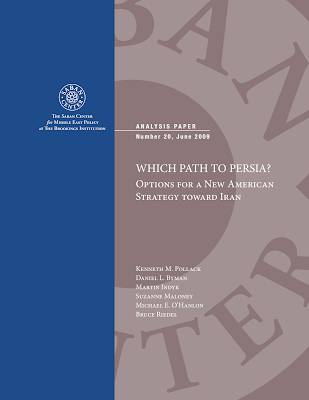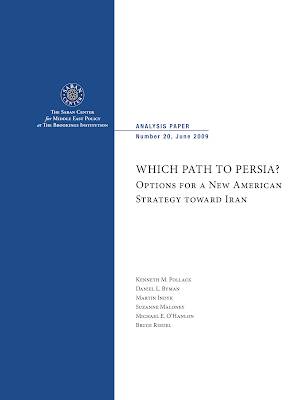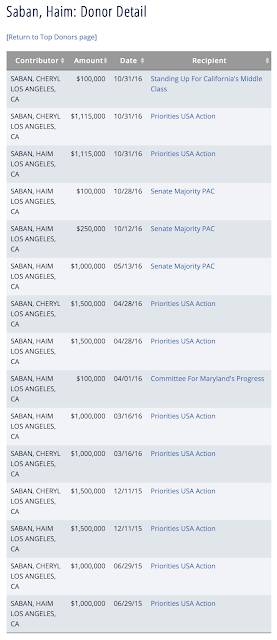
A publication from the Saban Center for Middle East Policy at the Brookings Institute, a very high profile Washington think tank, gives us an interesting viewpoint on the history behind Washington's approach to Iran. The analysis paper entitled "Which Path to Persia? Options for a New American Strategy Toward Iran" was published in June 2009 provides a blueprint for enacting regime change in Iran, a long-standing goal of Washington. For this posting, I will focus on Part III of the paper entitled Toppling Tehran: Regime Change which looks at the potential mechanisms which could be used by the United States to end the decades-long control of Iran by its religious leadership.
Here are the title page of the analysis paper and a page listing the authors:
Here is the opening section of Part III:
"For some Americans, neither the diplomatic nor the airstrike options offer a persuasive approach to Iran. They have little confidence that the Iranians can be persuaded—either with big incentives and disincentives, or with just the big incentives—and fear that airstrikes would fail to disarm Iran and instead would further entrench the clerical regime. Instead, they believe that only taking action to bring about the fall of the Islamic republic can protect America’s vital interests in the Middle East. These Americans see the regime itself, and not merely its behavior, as the real threat to U.S. security. They believe that the regime simply will never live up to any agreements, and even if somehow it did, it would find other ways to undermine U.S. interests because the regime and the United states are fundamentally incompatible. Consequently, Americans who fall into this camp tend to dislike both the diplomatic and airstrike options because none of them offer any reasonable prospect of ousting the regime. They might favor an invasion, but after Iraq and Afghanistan, they tend to believe either that the costs are not worth it or that the American people will not go for it. So for them, the only reasonable way to handle Iran is to pursue some form of covert action intended to bring about the end of the Islamic Republic.
The clerical regime in Iran is brutal and corrupt, and its leaders oppose U.S. interests throughout the Middle East. Thus it is not surprising that some Americans have examined the regime for cracks that could be widened to bring about its downfall. The surprising ascendance of a reform movement with the 1997 election of Muhammad Khatami made a change in regime seem possible, even imminent: not only did Khatami’s widespread support suggest considerable disenchantment with the clerical regime, but his election indicated that peaceful means might lead to its replacement under the leadership of a man calling for a “dialogue of civilizations.” over ten years later, however, Khatami’s conservative opponents have consolidated power. While many Iranians are cynical toward or even hostile to the regime, the reform movement is in disarray.
The reform movement, however, is not the only means for changing the regime, and in theory the United States has several options if it seeks a new Iranian government. in the past, the United states engineered a coup to restore a government of its liking there and in recent years, Washington has supported programs designed to bolster a democratic movement in Iran. Prominent voices have also called for helping Iranian oppositionists overthrow the regime and for using Iran’s minority groups to undermine the government." (my bolds)
The authors state that there are three options in which the United States could change the regime or undermine it as follows:
1.) A Velvet Revolution or popular uprising.
2.) Inspiring an insurgency.
3.) Supporting a military move against the current regime.
For the purposes of this posting, I want to focus on the Velvet Revolution or popular uprising option because the current Iranian regime is widely disliked by Iranians (at least according to the authors) and the most obvious type of bringing about its demise would be to foster a populist revolution similar to those that toppled the Communist governments throughout Eastern Europe in the late 1980s and early 1990s. Here's another quote from the analysis:
"For many proponents of regime change, it seems self-evident that the United States should encourage the Iranian people to take power in their own name, and that this would be the most legitimate method of regime change. after all, what Iranian or foreigner could object to helping the Iranian people fulfill their own desires?"
The authors state that history suggests that such an event is possible; in 1906 during the Constitutional Movement, the late 1930s and the 1978 Iranian Revolution show that coalitions of Iranians will mobilize against an unpopular regime. What they failed to mention was the United States led revolution that saw the democratically elected Prime Minister Mossadegh overthrown in 1953 so that the United Kingdom and the United States could control the massive oil reserves of Iran.
The goal of this policy which does not involve any military intervention would be to overthrow the clerical regime in Tehran and replace it with one that is more compatible with American interests in the region, hoping that the successor would not attempt to acquire nuclear weapons or stoke regional instability as they have been accused of in Syria and other nations in the Middle East. While the goal is to remove the regime, the authors state that Washington could work with Iran's internal opposition to coerce the ruling class into seeing things its way. It could also take the form of widespread popular demonstrations that discredit the clerical leadership and force it to abdicate their position of power.
Here's a quote showing the role that the United States could take:
"The United States could play multiple roles in facilitating a revolution. By funding and helping organize domestic rivals of the regime, the United States could create an alternative leadership to seize power. As Raymond Tanter of the Iran Policy commit- tee argues, students and other groups “need covert backing for their demonstrations. They need fax machines. They need internet access, funds to duplicate materials, and funds to keep vigilantes from beating them up.” Beyond this, U.S.-backed media outlets could highlight regime shortcomings and make otherwise obscure critics more prominent. The United States already supports Persian- language satellite television (Voice of America Persian) and radio (radio Farda) that bring unfiltered news to Iranians (in recent years, these have taken the lion’s share of overt U.S. funding for promoting democracy in Iran). U.S. economic pressure (and perhaps military pressure as well) can discredit the regime, making the population hungry for a rival leadership." (my bolds)
The authors continue by stating that the level of detailed intelligence on Iran is lacking because the U.S. does not have an embassy on the ground or any personnel in the country. This makes it extremely difficult to ascertain the latest developments on Iranian politics and the Iranian people. They do note that the current leadership in Iran has shown themselves to be willing to use force (military and police) to crush domestic unrest. This means that it is highly likely that Washington may have to provide military support to the opposition to prevent the current leadership from crushing the revolution.
Let's now look at the authors' views on the advantages of a popular uprising:
1.) It offers the greatest potential at the least cost, particularly when compared to a military invasion.
2.) Even if the popular uprising is unsuccessful at overthrowing the leadership of Iran, it will provide a domestic distraction which may limit Iran's ability to "make mischief" elsewhere.
3.) A steady long-term effort to bolster American-style democracy in Iran may pay off in years or decades to come.
4.) This approach will allow American intelligence services to increase penetration of Iran's military and security apparatus.
5.) This advantage is best quoted in its entirety:
"By adopting regime change as its policy, the United States can demonstrate a commitment to its democratic ideals that has been sadly lacking in past decades, a situation that has greatly damaged the status of the United States in the Muslim world. claims of double standards in democracy and “Arab Exceptionalism”—by which Middle Easterners mean that the United states promotes democracy everywhere else in the world except the Middle east, where it is comfortable with autocracies that guarantee the oil flow—are key elements of the anti-Americanism that dominates the Middle eastern street. If the Iranian regime continues to foment instability across the Middle east, and the United states and the international community are unwilling to stop it, at the very least, the United states would always be able to say that it never enabled or appeased that trend. Washington may not succeed in stopping Tehran, but it would not have been complicit in assisting it."
Let's now look at the authors' views on the disadvantages of a popular uprising:
1.) The current Iranian government is very well entrenched and has proven itself to be capable of resilience through many calamities.
2.) The current Iranian government has made it difficult for opposition movements to thrive, survive and gain supporters.
3.) Replacing an ousted regime with a new regime that will prove to be palatable to Washington over the long-term is difficult (as already experienced when the Shah of Iran replaced Prime Minister Mossadegh in 1953).
4.) A democratic regime change may prove not to be pro-American particularly given Iranian's long-term hatred of all things American.
5.) U.S. support for a popular uprising may backfire – since the 1978 revolution, American backing has been the "kiss of death" for internal Iranian opposition groups.
6.) Efforts to promote democracy and work with opposition leaders may prompt the current Iranian government to crackdown even harder on Iranian opposition leaders.
7.) The clerical leadership is unlikely to leave Iran without a fight that could lead to the deaths and imprisonments of thousands of Iranians.
8.) If Iran's leadership believe that the United States is directly supporting a popular uprising, they may take action to step up their support for guerrilla and terrorist groups. If they feel threatened further, they could also step up the nation's nuclear program and its military buildup.
I believe that is enough to digest for this posting. One must keep in mind the source of this study is the Saban Center for Middle East Policy located at the Brookings Institute. The Saban Institute was founded in 2002 with initial funding from Haim Saban, an American-Israeli film and television producer. According to Forbes, his net worth in 2019 was estimated at $2.8 billion. He was a significant donor to Hillary Clinton's campaign in 2016 through her Priorities USA Action SuperPAC as shown here:
Given Mr. Saban's very close links to Israel and Israel's hatred for Iran, you can assure yourself that this analysis providing a mechanism for how Washington could implement a regime change roadmap of Iran as supplied by the Saban Center for Middle East Policy was far from unbiased in favour of fulfilling Israel's vision for a Middle East without Iran. As well, given that the Brookings Institution is one of the most influential think tanks in Washington, providing policy recommendations and analysis on a broad range of public policy issues to Congress and Washington insiders as a whole should cause us to wonder exactly who was behind the most recent protests in Iran. I suspect that we all know the answer to that question.
Click HERE to read more from this author.
You can publish this article on your website as long as you provide a link back to this page.




Be the first to comment